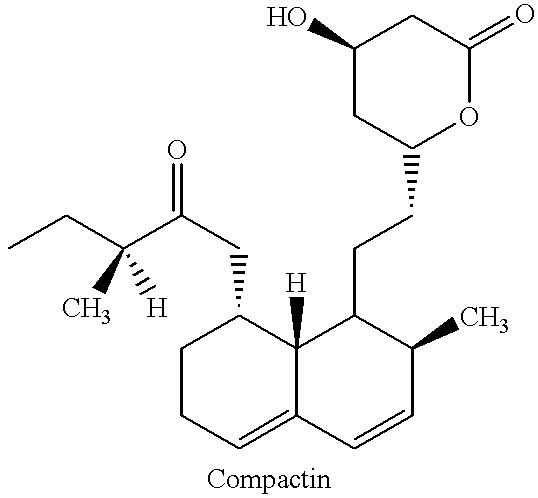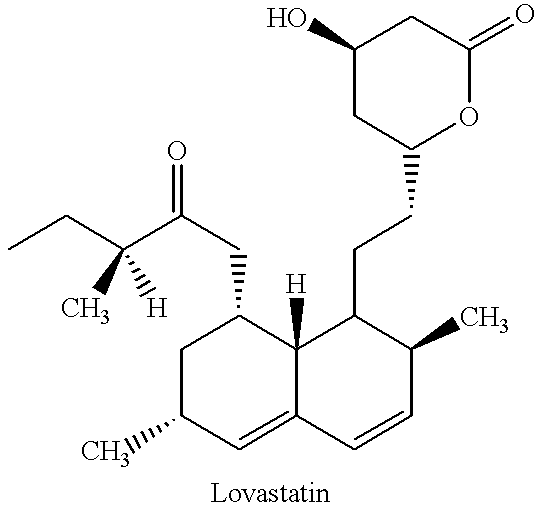Method of purifying statins from a fermentation broth
a technology of statin and fermentation broth, which is applied in the direction of drug composition, separation process, cardiovascular disorder, etc., can solve the problem that the purity level of isolating a statin from a fermentation broth is not pharmaceutically acceptabl
- Summary
- Abstract
- Description
- Claims
- Application Information
AI Technical Summary
Benefits of technology
Problems solved by technology
Method used
Image
Examples
example 1
Isolation of Compactin
A fermentation broth (70 m.sup.3) containing 350 kg compactin was prepared by methods well known in the art. (See, e.g., U.S. Pat. Nos. 3,983,140; 4,049,495 and 5,691,173). i-Butyl acetate (35 m.sup.3) and water (35 m.sup.3) were added to the aqueous fermentation broth (70 m.sup.3) in a continuous way. The pH was adjusted to about 9.0-9.6 by addition of concentrated NaOH. The mixture was then heated to 60.degree. C. and maintained at that temperature for 2 hours. The resulting organic and aqueous phases were then separated using counter current separation. Sodium lauryl sulfate was added to help de-emulsify the mixture during the separation.
The purified fermentation broth was acidified to a pH of about 2.0-4.5 with sulfuric acid. i-Butyl acetate (35 m.sup.3) was then added continuously and after mixing in situ, the i-butyl acetate phase containing compactin was separated continuously.
The i-butyl acetate phase was concentrated under vacuum to a volume of about 2...
example 2
Isolation of Compactin without the Pre-Purification Step of Fermentation Broth Under Alkaline Conditions
A fermentation broth containing compactin was prepared as in Example 1. The fermentation broth (50 L) was acidified to a pH of about 2.0-4.5 with sulfuric acid. i-Butyl acetate (25 L) and water (25 L) were then added and after mixing for about 0.5 hour, the i-butyl acetate phase containing compactin was separated. The extraction was repeated with pure i-butyl acetate (25 L). The combined i-butyl acetate phase was concentrated under vacuum to a volume of about 1.5 L. The concentrated solution was allowed to stand at 0-5.degree. C. overnight, whereupon compactin crystalized in 33% (w / w) yield and 94.5% (w / w) purity. While Example 1 exemplifies the use of alkaline extraction, Example 2 differs in that it illustrates the use of the technologies without the alkaline extraction.
example 3
Isolation of Compactin Pre-Treatment of Fermentation Broth Under Alkaline Conditions of Concentrated i-Butyl Acetate and Washing with NaHCO.sub.3
A fermentation broth was prepared as in Example 1. i-Butyl acetate (25 L) and water (25 L) were added to an aqueous fermentation broth (50 L). The pH was adjusted to about 9.0-about 9.6 by addition of concentrated NaOH. The mixture was then heated to about 60.degree. C. and maintained at that temperature for about 2 hours. The phases were then separated. Dodecyl trimethyl ammonium chloride was added to help de-emulsify the mixture during the separation. The purified fermentation broth was acidified to a pH of about 2.0-4.5 with sulfuric acid. i-Butyl acetate (25 L) was then added and after mixing for about 0.5 hour, the i-butyl acetate phase containing compactin was separated. The acid extraction was repeated with pure i-butyl acetate (25 L).
The combined i-butyl acetate phase was concentrated under vacuum to a volume of about 1.5 L. The con...
PUM
| Property | Measurement | Unit |
|---|---|---|
| Fraction | aaaaa | aaaaa |
| Time | aaaaa | aaaaa |
| Time | aaaaa | aaaaa |
Abstract
Description
Claims
Application Information
 Login to View More
Login to View More - R&D
- Intellectual Property
- Life Sciences
- Materials
- Tech Scout
- Unparalleled Data Quality
- Higher Quality Content
- 60% Fewer Hallucinations
Browse by: Latest US Patents, China's latest patents, Technical Efficacy Thesaurus, Application Domain, Technology Topic, Popular Technical Reports.
© 2025 PatSnap. All rights reserved.Legal|Privacy policy|Modern Slavery Act Transparency Statement|Sitemap|About US| Contact US: help@patsnap.com



